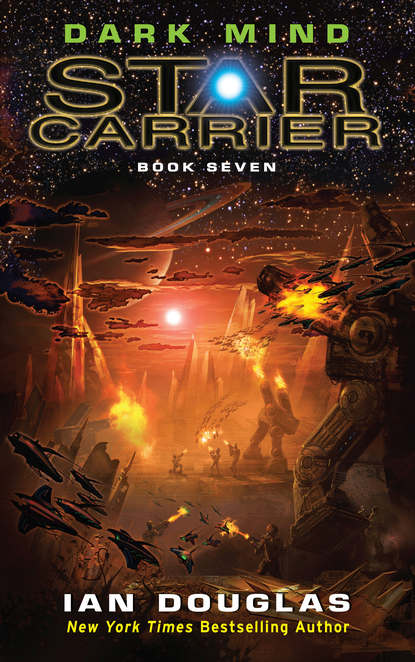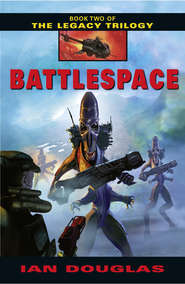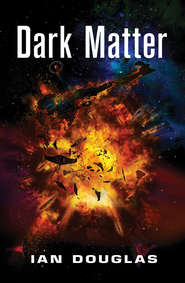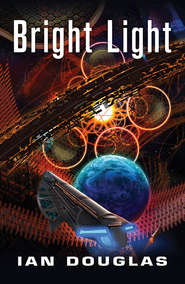По всем вопросам обращайтесь на: info@litportal.ru
(©) 2003-2025.
✖
Dark Mind
Настройки чтения
Размер шрифта
Высота строк
Поля
“A machine some thousands of times smarter—and millions of times faster—than any organic brain we’ve encountered.”
“That’s right. Smarter … so smart we don’t know what it’s really thinking. Or what it’s planning for the future.”
He smiled. “Perhaps you’d like to sit in on the next meeting of my cabinet.”
She looked shocked. “Oh! I’m sorry! I didn’t mean to suggest—”
He waved her down with a gentle motion of his hand. “No, no. That’s okay. I was just picturing you tearing into Sarah Taylor, the secretary of Alien Affairs. Or Phil Caldwell. It might be fun.”
A USNA admiral in full dress approached them. “Do you need rescuing, Mr. President?”
“Not at all, Vince. The governor was just … questioning certain affairs of state.”
Admiral Vincent Lodge smiled at Ashton. “Maybe you need rescuing from him.”
“I think I can watch out for myself, Admiral.”
“Good.” He looked at Koenig, and some of the humor drained from his eyes. “Mr. President? A word, if I could?”
“Excuse us, Ms. Ashton?”
“Of course.”
They stepped aside. “What’s the word?”
“Mr. President … we’ve received a Konstantin intercept.”
Konstantin had intelligence connections imbedded all over Earth, and well beyond. Admiral Lodge was the head of Naval Intelligence … the human head, rather, since in many ways Konstantin was the true director of cyberintelligence. A Konstantin intercept meant that the AI had picked up a transmission of some sort, probably classified and definitely important, if Lodge was interrupting him at a party about it.
“Tell me.”
“A courier just dropped into normal space outside Neptune’s orbit and began transmitting. It’s from Kapteyn’s Star … from the Pan-European monitor they sent out there.”
“Go on …” Couriers were high-speed interstellar vessels, usually unmanned, that could make the Alcubierre passage between the stars much more quickly than larger, more cumbersome star-faring vessels. They wouldn’t have sent one if things weren’t critical.
“We know what the Rosettes are doing at Heimdall, sir. They’re waking up the Kapteyns. They may be assimilating them.”
“The Kapteyns!”
“Yes, sir. And for the first time, we just may have gotten a glimpse of what the Rosette Aliens are after.”
“You have my full attention,” Koenig told him.
Chapter Two (#ulink_624f2e0f-4827-584b-befc-1a1d146900cd)
29 October 2425
TC/USNA CVS America
Admiral’s Quarters
0425 hours, TFT
Admiral Trevor “Sandy” Gray came awake in a darkened and empty room. Still half asleep, he clawed at the loneliness of the bed next to him. Where was she? It took him several moments to figure out where he was … his quarters on board the star carrier America.
Damn … it had seemed so real.
But then, it always did.
His partner in the erotincounter had been named Marie; for once she had not been Angela, his one-time wife, nor had it been his most recent partner, Laurie Taggart, who’d recently been transferred to the Lexington. Marie was pure fiction, created by one of America’s AIs, and very loosely based on a current sex-drama actress who went by the same name. In-head dramas, fed into people’s internal hardware, were a major source of both entertainment and education. Gray preferred interacting with electronic avatars to address his sexual desires, rather than sexbots. The sensations and results were the same … but the relationship played out inside his brain rather than in his bed. So when the illusion dissolved, so did the partner. The feeling was precisely that of waking from a dream, and that could leave you feeling empty and a bit lonely.
“Admiral Gray,” a voice whispered in his head. “Admiral Gray. Sorry to wake you, sir, but we’re coming up on the triggah.”
“Very well,” he replied. The voice was that of Eric Conrad, his new chief of staff. He sat up, stretched, and thoughtclicked the room’s lights to higher brightness.
Unlike a dream, the memory of his encounter with Marie hadn’t evaporated upon waking. The memories were written directly to his long-term memory; the human brain literally could not tell the difference between what happened within its network of neurons and what happened in the real world outside.
Somehow, that made the loneliness worse.
But it kept his sex life uncomplicated.
“How close are we?” he asked over the open circuit. He took a small capsule from a dispenser and slapped it against his naked chest. The nanomaterial turned semi-liquid with the shock and flowed swiftly over his body from neck to feet, solidifying in seconds into closely woven shipboard utilities, complete with rank tabs at the throat.
“Twelve thousand kilometers, sir,” Conrad replied. “We have battlespace drones out, and they’re sending back some good images.”
“Let me see.”
The bulkheads of Gray’s quarters went dark, then lit once more, showing a projection of surrounding deep space. Stars hung suspended in velvet blackness. Directly ahead, robot drones sent back images of the TRGA—the Texaghu Resch Gravitational Anomaly. From this aspect, it appeared to be a perfect circle, gray-rimmed, surrounded by a faint haze of dust and debris.
Properly known either as the Sh’daar Node or as the TRGA, the circle was in fact a hollow cylinder of ultra-dense matter twelve kilometers long and one wide, rotating about its long axis at close to the speed of light. Located over 200 light years from Sol, the TRGA—a “triggah” in Navy slang—was clearly artificial and clearly the product of an unimaginably advanced technology. There were others besides this one—tens of thousands, perhaps, scattered across the galaxy as a kind of spacetime transportation net. At one time, Earth Military Intelligence had believed that the alien Sh’daar had created the things; certainly they used them, as did human star-farers. But no one knew for sure who’d actually built them in the first place, not even the information traders known to Humankind as the Agletsch. They worked, and for most people, that was enough.
This particular TRGA was the first one discovered by human explorers, thanks to information provided by Agletsch traders. Just recently, it had been given the code name Tipler, after twentieth-century physicist Frank Tipler, who had worked out the math for Tipler cylinders—titanic, ultra-massive constructs that might allow travel across vast areas of space and even through time. The TRGAs had turned out to be related to Tipler cylinders, but inside out—rotating hollow tubes rather than solid cylinders—though the effect was the same.
Perhaps a dozen TRGAs were now known, all of them named for important physicists and cosmologists from the past few centuries.
Sometimes Gray wondered if they’d have been surprised to see their theories become reality.
The circle slowly grew larger in size as America and her supporting fleet approached it. That cylinder, Gray knew, held the mass of a sun the size of Sol somehow compressed into something akin to neutron-star material. Inside that fast-rotating shell, Jupiter-sized masses rotated and counter-rotated, stretching local spacetime beyond the breaking point. That haze was in part dust, and in part gravitational distortions in the space within which the triggah was imbedded.
And they were about to go through it.
“Fighter status?” Gray asked.
“VFA-96 is ready for launch, Admiral,” the staff officer replied. “Awaiting your word.”
“Launch fighters,” Gray replied. “And go to battle stations.”
He was already on his way up to America’s bridge as the battle-station alarms sounded.











